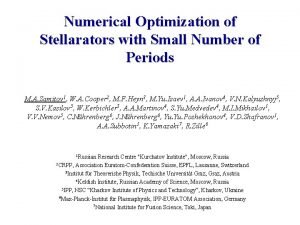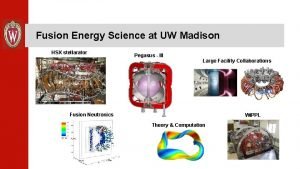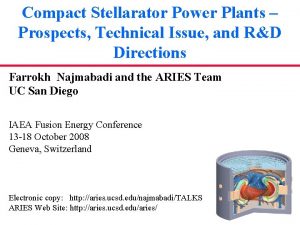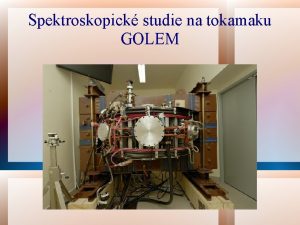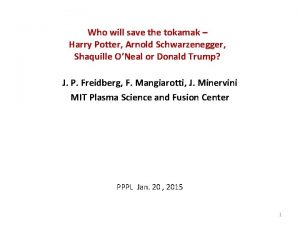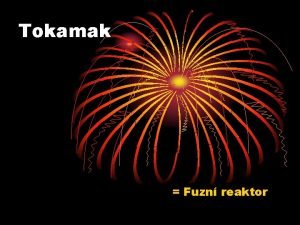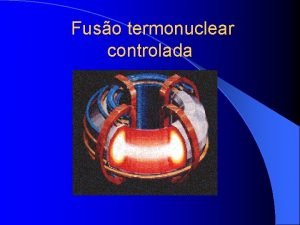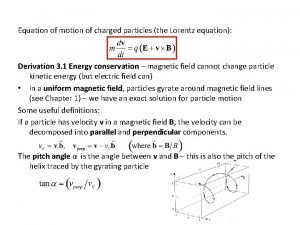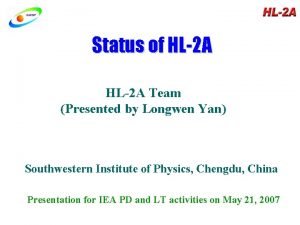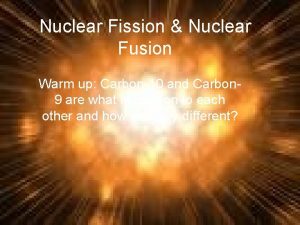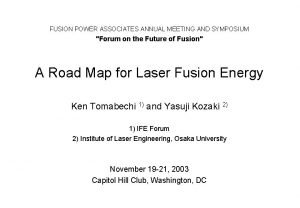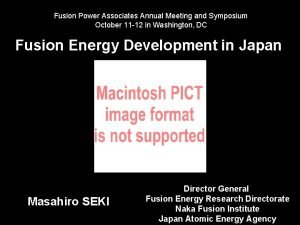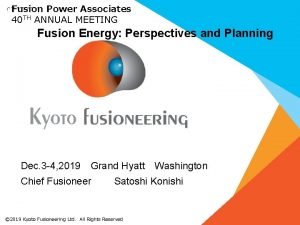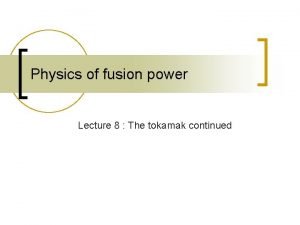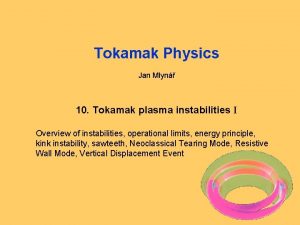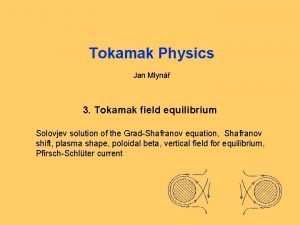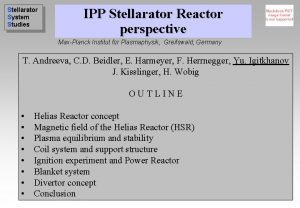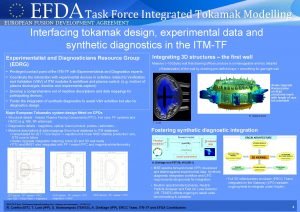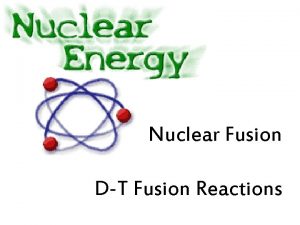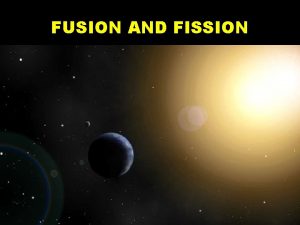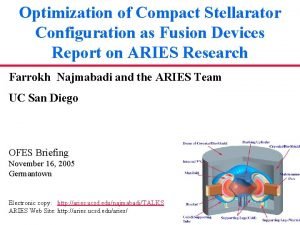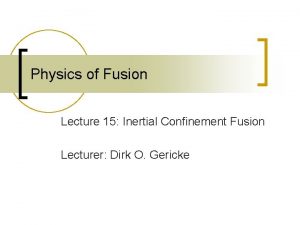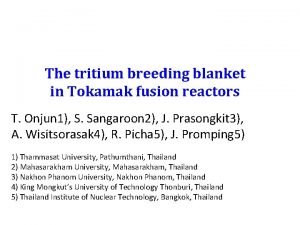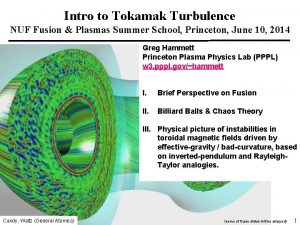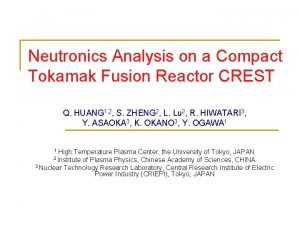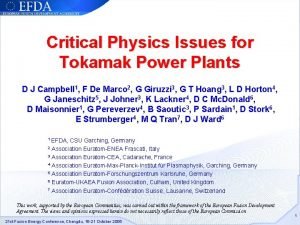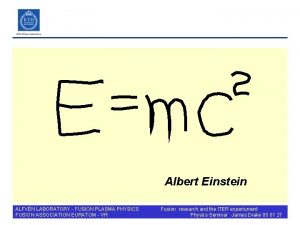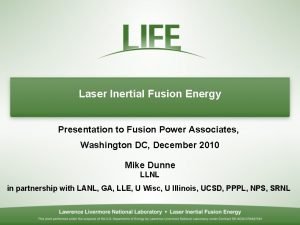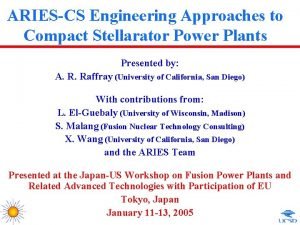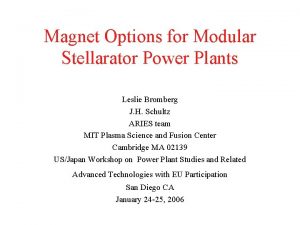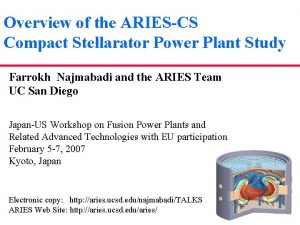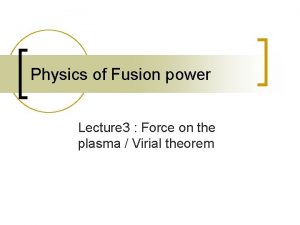Physics of Fusion power Lecture 7 Stellarator Tokamak






























- Slides: 30

Physics of Fusion power Lecture 7: Stellarator / Tokamak

Toroidal curvature has its price n Plasma wants to escape the magnetic field n The Ex. B velocity n Is directed outward and will move the plasma on the wall in a short timescale Remedy is the toroidal plasma current n Poloidal cut of the tokamak.

Remedy : a plasma current n n A toroidal current in the plasma will generate a poloidal field Top and bottom are connected by the magnetic field line A vertical electric field would have a component along the field and leads to acceleration of the ions / electrons Drift will be balanced by a return flow along the field Poloidal cut of the tokamak.

Maybe easier to understand n n For every toroidal angle the ions drift up and the electrons drift down A helical field line will therefore connected the regions of ‘positive and negative’ charge Electrons are accelerated along the field line, and neutrality can be maintained Note it does lead to parallel flows (with a toroidal component) Attempt at a 3 D view. The toroidal plasma is drawn as a cylinder

Same thing again n n Poloidal projection of the flow pattern (ions as well as electrons) is closed in the poloidal plane In every small volume the ions leaving the volume are replaced by the ions entering No charge separation Note, this is of course a cartoon picture.

Do we really need the plasma current? n It might at first appear obvious that the answer is yes since without current inside the plasma n But a positive as well as negative poloidal field does not necessarily mean that the field line on average does not go around poloidally On average the field line can go around even if the enclosed current is zero.

Toroidal symmetry n n n With zero current at some point the poloidal field must be zero In the case of toroidal symmetry this field line closes upon itself Regions of positive and negative field are not connected A field line can not wind around poloidally Then top and bottom can not be connected With toroidal symmetry one field line can not wind around poloidally

Same thing again Poloidal winding of a zero current device with toroidal symmetry n n n Field lines will move towards the field line with zero poloidal field For zero field the field line closes upon it self No magnetic field line can cross this line The field line can not wind around poloidally No flow from top to bottom is possible -> No equilibrium

The stellarator n n n If the field is not toroidally symmetric the motion in the toroidal direction will move the field line from regions of positive poloidal field into regions of negative field Then a net poloidal turn of the field line can be achieved Steady state operation is possible at the cost of greater complexity

Same thing again Poloidal winding of a zero current device without toroidal symmetry n n Without toroidal symmetry to toroidal field can move the field line from the region of positive poloidal to negative poloidal field With the correct shaping of the surfaces one can impose a net transform of the field line Top and bottom can be connected An equilibrium exists

Large Helical Device (LHD, Japan)

Stellarator n n Inside the device it looks something like this Picture from LHD in JAPAN

Larges tokamak: JET (EU, UK) n n n Major radius 3 m Minor radius 1. m Magnetic field < 4 T Plasma volume 100 m 3 Plasma current < 7 MA Plasma duration 10 s

Comparison of confinement time n n Confinement times of LHD are below those of the large tokamaks This is mostly due to the smaller plasma volume LHD Confinement time of tokamaks and stellarators compared

Hellical coils can be simplified n The picture shows how the combination of helical coils and toroidal field coils can be changed to use modular coils

Applied in W 7 X n n n Modular coils of W 7 x There is a large disadvantage in the use of the modular coils. They are highly bend and therefore there are large force on them In general it is difficult to build a compact device with a big plasma. The poloidal field one imposes from the outside decays rapidly with distance from the coils

Compact stellarator NCSX princeton Compact stellarotors are a challenge. Note there is a plasma current in this device (not driven by a transformed though)

Tokamak versus stellarator Advantage of the stellarator n Stationary plasma operation n No current in the plasma, and therefore no current driven instabilities Disadvantage n Complex magnetic field coils n Curved coils lead to large forces (strong supporting structures) n Difficult to make compact devices

A tokamak n n n Plasma (purple) Notice the shape Surrounded by plates Vessel (pumps) Coils mostly outside vessel (finite reaction time) Ohmic transformer / toroidal field coils (green) Schematic Drawing of the poloidal cross section of the ASDEX Upgrade tokamak

The tokamak n n n Magnetic surfaces are the surfaces traced out by the magnetic field They are nested (best confinement) Centre is shifted outward Large passive coils Magnetic field ends on a set of plates Large set of small coils for diagnostic purposes Schematic Drawing of the poloidal cross section of the ASDEX Upgrade tokamak


Pitch of the field n Along the magnetic field n Consequently the length of the field line in toroidal direction is Pitch of the field line

Pitch of the magnetic field n Length of the field n In one poloidal turn n Number of toroidal turns in one poloidal turn (safety factor q) Definition of the minor r and major R radius

Kink stability n n Relation with the current For stable operation the safety factor at the edge is chosen q > 3. The means a maximum current Stability considerations of the screwpinch also apply to the tokamak


Ratio of poloidal and poloidal field n From the safety factor it follows n Therefore the ratio between the poloidal and toroidal field is

Pressure and current n From the force balance n Taking the inner product with the magnetic field n The pressure gradient is perpendicular to the surface Pressure is constant on a surface n Pressure is constant on the magnetic surface, and the current lies inside the surface

Pressure and current n Again using the force balance n Taking the cross product with the magnetic field n Since the pressure gradient is perpendicular to the surface the current lies inside the surface Pressure is constant on the magnetic surface, and the current lies inside the surface

Poloidal flux n n The poloidal flux y(R, z) is the flux through the circle with its centre at r = 0 lying in the z-plane and having (R, z) lying on its boundary Integrated over a volume enclosed by two of these circles and the magnetic surface yields Point (R, z) (R 2, z 2) The poloidal flux is the flux through the blue areas. It is constant on a magnetic surface

Magnetic surfaces n n Traced out by the magnetic field The pressure is constant on the surface The current lies inside the surface The poloidal flux is constant on a surface. The surfaces are therefore also called flux-surfaces
 Stellarator
Stellarator Hsx uw madison
Hsx uw madison Stellarator
Stellarator Tokamak golem
Tokamak golem Tokamak
Tokamak Fuzn
Fuzn Tokamak működése
Tokamak működése Tokamak
Tokamak Tokamak hl-2m
Tokamak hl-2m Tokamak
Tokamak Equation of motion
Equation of motion Hl2 tokamak
Hl2 tokamak 01:640:244 lecture notes - lecture 15: plat, idah, farad
01:640:244 lecture notes - lecture 15: plat, idah, farad Active power reactive power apparent power
Active power reactive power apparent power Who discovered uranium
Who discovered uranium Ti fusion digital power designer
Ti fusion digital power designer Fusion power associates
Fusion power associates Fusion power associates
Fusion power associates Fusion power associates
Fusion power associates Physics 111 lecture notes
Physics 111 lecture notes What is a harmonic wave in physics
What is a harmonic wave in physics Phy101 lecture 1
Phy101 lecture 1 Physics 101 lecture notes pdf
Physics 101 lecture notes pdf Waves physics notes
Waves physics notes Atmospheric physics lecture notes
Atmospheric physics lecture notes Power system dynamics and stability lecture notes
Power system dynamics and stability lecture notes Zline 667-36
Zline 667-36 Power semiconductor devices lecture notes
Power semiconductor devices lecture notes Switch mode power supply lecture notes
Switch mode power supply lecture notes Power system dynamics and stability lecture notes
Power system dynamics and stability lecture notes Why does it happen
Why does it happen
